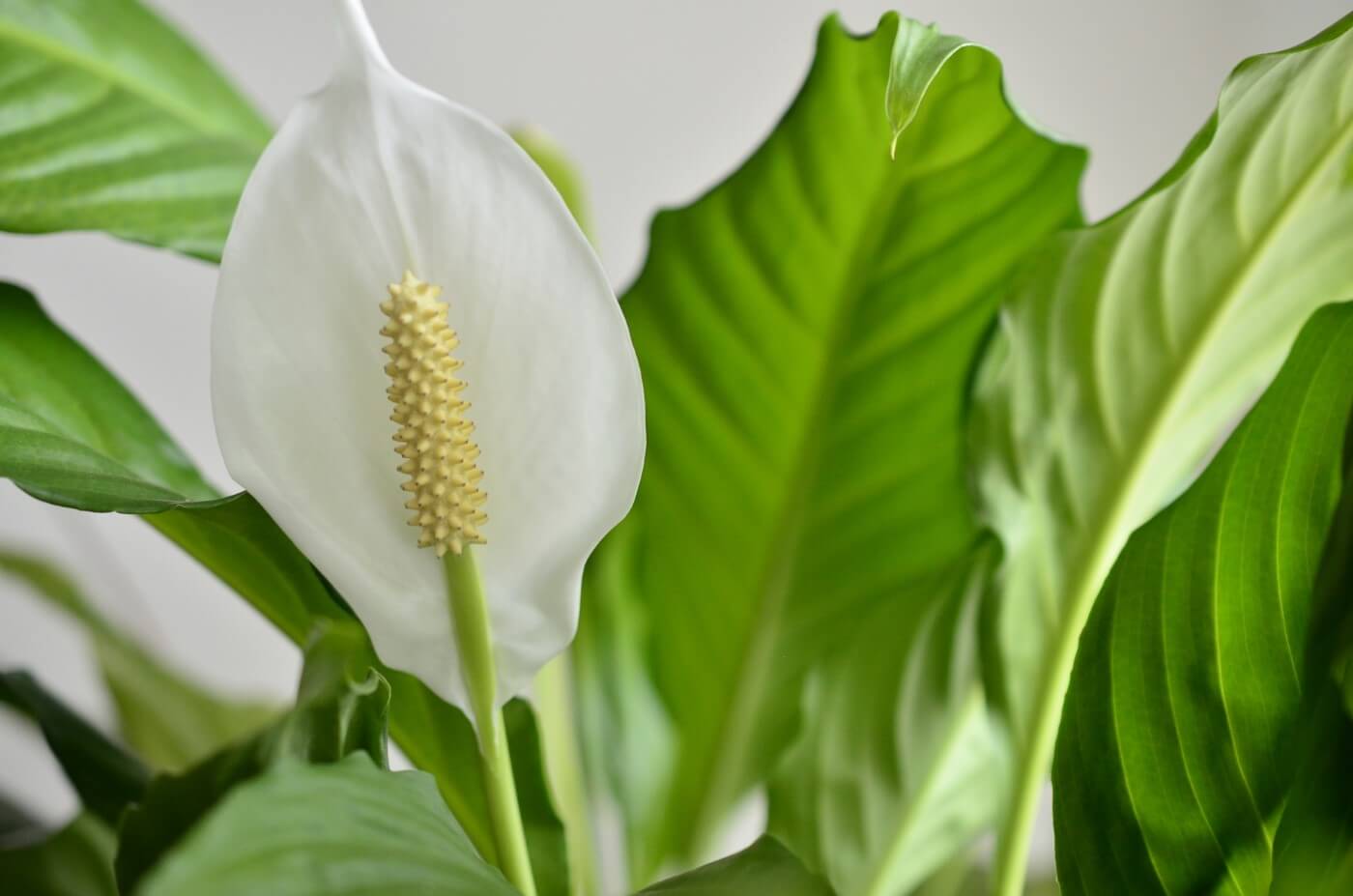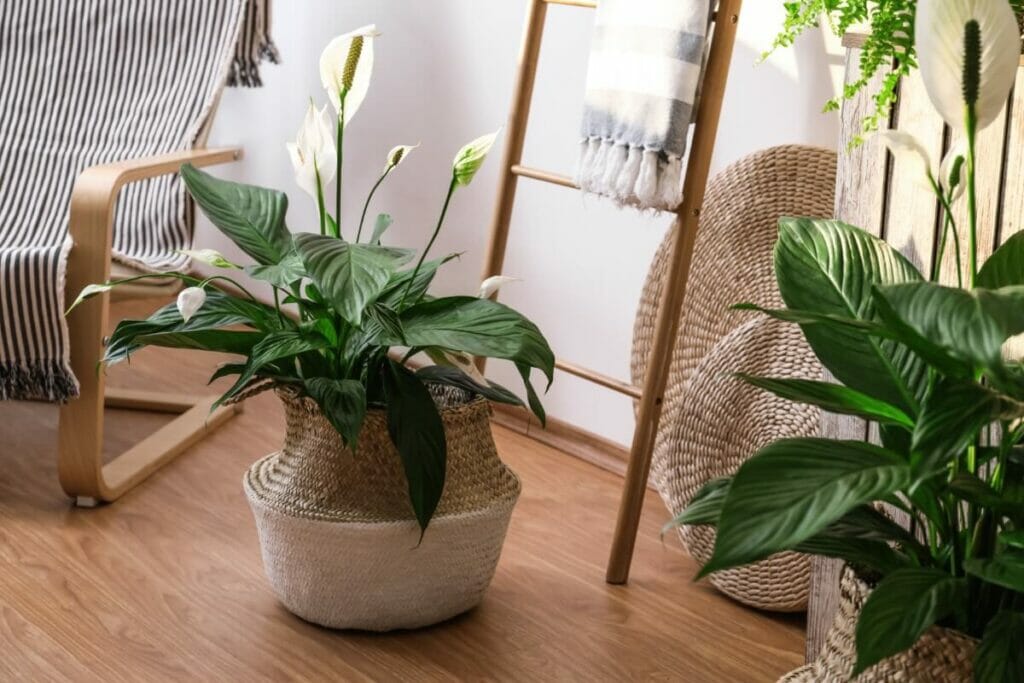My Favorite Soil Mix for Peace Lily Plants at Home
A prolific and productive Peace Lily (Spathiphyllum) requires a growing medium capable of holding some water but still draining well. In my experience, these plants also need acidic soils with a pH range between 5.8 and 6.5. My favorite Peace Lily soil mix ratio consists of a 2:2:1 blend of standard houseplant compost, sand, and bark or perlite. Make sure you’re setting your Peace Lily up for success with this helpful guide to the best soil types for thriving and healthy plants.

The Ultimate Peace Lily Plant Potting Mix Recipe
I find that the best Peace Lily plant potting mix can vary from something quick and easy to a blend of extravagant ingredients. As long as you combine some elements that aid nutrition with ones that enhance drainage, your Peace Lily will thrive.
In their indigenous habitats, Peace Lily plants grow underneath the canopy of the tropical rainforest. These soils contain a lot of decaying plants and other waste material. This makes them fairly acidic. To replicate this at home, Peace Lilies need soils with pH levels ranging between 5.8 and 6.5.
Components of a Great Peace Lily Plant Potting Mix
Potting Soil – the soil provides the basic framework for your potting medium. Ideally, you want something light, aerated in texture, and comprising organic and aged natural matter.
Horticultural sand – this very coarse ‘sand’ typically comprises crushed stones such as quartz, granite, or sandstone.
Sphagnum peat moss has fine particles yet a coarse texture. This leads to great water-holding and nutrient-holding capacities, along with good aeration.
Coco coir is made from the husks of coconuts. It has a similar texture to peat moss but compacts a bit more over time.
Pine bark fines are small pieces of coniferous trees such as firs, pines, and spruces. This bark has a high percentage of lignin, which means it retains its shape over time. Therefore, it’s excellent at resisting compaction and providing air pockets.
Perlite is a type of expanded rock. It looks and feels a lot like styrofoam. It does not absorb water, so it is great at providing aeration and drainage to a soil mix.
My Go-To Peace Lily Soil Mix
Now that you understand a bit about what each component provides to a potting mix, here’s a great recipe that I follow. It offers excellent aeration and drainage yet also holds enough water for your plant to take up all it needs.
- Cactus or houseplant potting soil mix (2 parts)
- Coarse horticultural sand (2 parts)
- Coconut coir or orchid bark or perlite (1 part)
I take two parts of the cactus or houseplant soil mix. This provides the nutrition for your Peace Lily. Blend this with two parts of coarse sand. This really improves the draining capability of the mix.
Finally, I add in one part of something like coconut coir, orchid bark, or perlite. These elements provide even more drainage to the soil while also improving airflow. There’s no need to add water to the mix, but give the plant a drink once you’re done.
Cactus soil will work well for this plant, but you may want to consider add-ins like a small amount of compost. This can help increase the nutrition your peace lily plant receives.
The Fundamentals of Well-Draining Soil

Providing sufficient drainage in your Peace Lily’s growing medium is the best way to combat overwatering (and is especially important for recently propagated peace lilies). If too much water is allowed to remain in the soil, the roots will get saturated and will quickly start to rot. This severely inhibits the development of the plant, stunting the foliage and affecting the flowers.
However, if the soil allows for sufficient drainage, these problems are avoided. While houseplant potting mixes contain plenty of nutrients, they can also be quite dense on their own. To make these soils suitable for Peace Lily plants, I like to blend in some drainage ingredients such as coconut coir, perlite, or coarse sand.
Soil Considerations Based on Pot Choice

Choosing the right kind of pot also helps provide the best soil for a Peace Lily plant. Different pot materials have different characteristics when it comes to moisture retention. I find that plastic nursery pots are ideal, helping to keep just enough humidity in the soil.
However, these pots must have drainage holes to help excess water escape. Ceramic and terracotta pots aren’t as effective because they can allow too much moisture to escape.
Soil Considerations When Repotting
The repotting process is a great opportunity to revitalize a Peace Lily’s soil. My Peace Lilies usually need to be repotted once a year, preferably in the early spring. I always pay special attention to the soil for the new pot, making sure that it drains well.
Use a fresh potting medium to bring in more nutrients, but mix in some soil from the old pot as well. Add a bit of perlite and sand to ensure good drainage.
Can You Use Cactus or Orchid Soil Mixes?
Because Peace Lily plants need a well-draining growing medium, cactus and orchid soil mixes seem ideal. Cactus and succulent composts tend to have sand or other drainage ingredients to keep things loose.
But Peace Lilies don’t just need well-draining soil. They also need plenty of nutrition and fertilizer to help their flowers and foliage grow at their best. Some cactus mixes may not provide adequate nutrition on their own, so I’d recommend blending in some standard potting mix as well.
Orchid mixes can also be a good ingredient for Peace Lily soil. Again, they provide loose soil that drains well and provides some nutrients. Alternatively, you can add some orchid bark to organic houseplant compost for extra drainage.
Common Signs You’re Using the Wrong Soil Mix
As jungle natives, Peace Lilies need good drainage in their soil to filter out large amounts of water. A good growing medium also needs to provide aeration, which basically means allowing the roots to access oxygen.
If the soil is too dense, it will hold far too much water. This inhibits airflow around the roots, essentially drowning them and all but killing the plant. The overwatering symptoms listed below can demonstrate that you might be using the wrong soil:
- Brown tips on foliage
- Sagging leaves (also a symptom of underwatering – check the feel of the soil)
- Rotting roots
- Yellowing Peace Lily foliage
- Drooping Peace Lily Leaves
The Role of Soil in Plant Growth and Health
A plant’s roots are essentially a digestive and nervous system rolled into one. Using the nutrients, oxygen, and water in the right soil, plants can distribute these resources throughout their stems. This helps plants develop fabulous foliage or beautiful blooms.
But not all plants require the same type of soil. That’s why providing the right soil mixture for Peace Lily plants is so crucial. Without sufficient nutrition and resources, your Peace Lily will struggle to produce those swan-like flowers that we know and love.
Along with positioning your peace lily plant in a spot with suitable light exposure and watering sufficiently, maintaining optimal soil composition also helps protect plants from pests and pathogens, helping your Peace Lily to thrive for years.
Wrap Up
If you give your Peace Lily a well-draining but nutritious growing mix, it’ll reward you with bountiful blooms and lovely leaves. These kinds of soils also help stimulate aeration in the soil. With the right soil, you and your Peace Lily plant will enjoy peace of mind for many years to come.
For more, see our in-depth guide to peace lily plant care at home.
Andrew is the Editorial Director at Petal Republic. He holds a BSc degree in Plant Sciences and has trained professionally at leading floristry schools in London and Paris. In amongst overseeing a global editorial team, Andrew's a passionate content creator around all things flowers, floral design, gardening, and houseplants.
